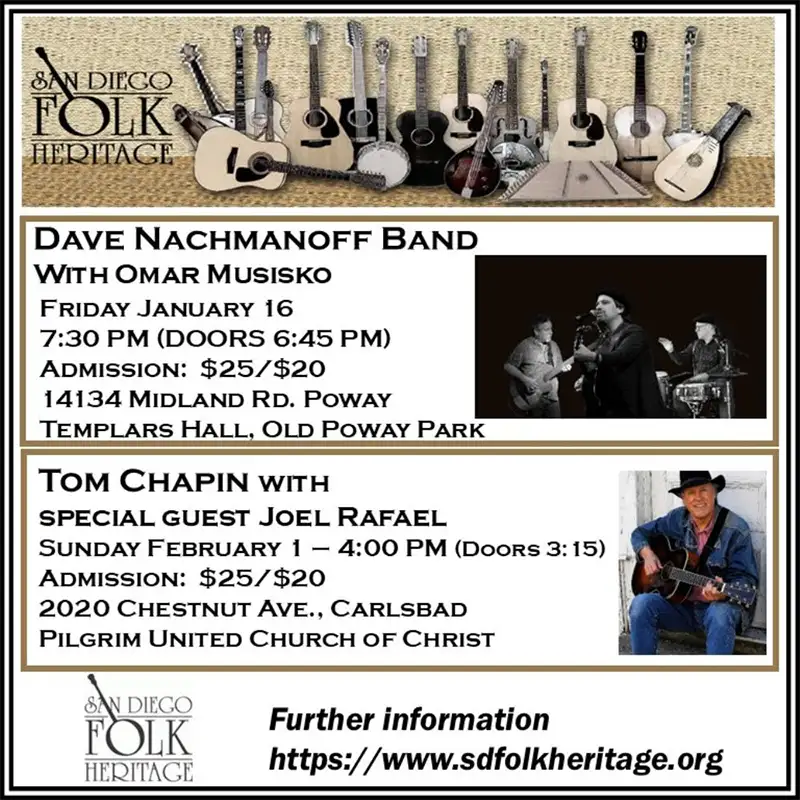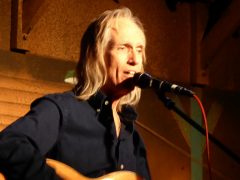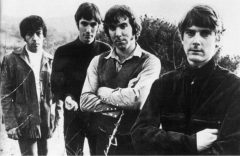Tales From The Road
John York and the Legacy of the Byrds
When John York steps out on the stage he embodies the era that helped to shape and form him as a musician, an artist, and a human being. There is a grace in talking with York in this recent interview as he recalls, with candid honesty, his time in the Byrds. His year (1968) with the legendary band came at a time when front man and the only original member, Roger McGuinn, was rebuilding the band. The members, along with York on bass and vocals, were Gene Parsons on drums and the legendary Clarence White on lead guitar. After York left the band he continued touring, most notably in 1985, with a version of the Byrds that included Mike Clarke and Gene Clark. Along for the ride were Blondie Chaplin, Richard Manuel, Rick Danko, and Nicky Hopkins. When he left the road and settled in Claremont, California, York began to explore world music. As he reveals, it was a way of re-defining himself from the guy who was in the Byrds. Today, after years of extensive touring with Barry McGuire, John York is happy to identify himself as a part of the legacy of the Byrds. It’s a place of honor with roots that run deep. When York plays live, there is not an ounce of imitation to his performances. He approaches many of the songs of Dylan, the Band, the Beatles, and the Stones like a jazz player. There is a sense of experimentation and life to his shows that betrays any sense of nostalgia. Over the years his interpretations of songs like “Eight Miles High” have grown into something of living art. And this is what he will bring to San Diego as he takes the stage at the annual Adams Avenue Unplugged event. It is a night not to be missed. The following interview is a clear demonstration of how one musician has evolved from a self-described, “young and foolish” kid to a wise and empathetic elder statesmen of the folk rock movement.
San Diego Troubadour: Will you be doing your York Sings Dylan show in San Diego?
John York: Well, I’ll be doing a lot of Dylan and some Beatles, plenty of Byrds songs, and a few originals. They gave me 75 minutes to do whatever I’d like. A lot of the Dylan show will be in the set because I do so much of his music anyway.
SDT: There’s a feeling when you’re doing Dylan that we’re getting to hear how the Byrds may have sounded doing these songs.
JY: I’ll take that as a compliment. It’s like here’s a guy who was in the Byrds doing some songs the Byrds never got to do. It’s a formula that seems to be working.
SDT: Let’s jump right into your time with the Byrds in 1968. In Wikipedia’s bio for you, it says you were really disenchanted with the band, which led to your being fired.
JY: There’s some truth in that. I was just young and stupid. When a guy in the band gets to be unhappy, they have to go. It’s like having four people in a boat with only three rowing. I became that guy. Looking back, I can see there was great creative opportunity that I could have gained, especially in the company of Roger, Clarence, and Gene. But I didn’t see it that way.
SDT: You were looking for another musical direction?
JY: Yeah. I had this whole other idea of what I wanted to do, musically. Like I wanted to play piano. I was tired of just being the bass player. I couldn’t see the value of keeping that music alive. At that time who knew this music was going to be so important culturally. It was, for me, just another gig. Another thing that made me so unhappy was that every band I had ever been that was well known, I was always the guy who came in to replace somebody who got fired or quit when the band was falling apart. Like with the Sir Douglas Quintet. They were completely falling apart. I could see what was needed because I was a bass player who could sing. So, I helped to rebuild the band. By the time I got to the Byrds I was really good at coming into a situation and figuring out what was necessary. For the Byrds it was singing the high parts and playing the bass. Then, I got really bored. Because there was nothing challenging for me to do. Of course, that was a complete misconception on my part. When you’re young and stupid you project your own feelings of inadequacy into the situation. That’s exactly what I did. It got to the point where I was supposed to be in the studio paying attention to what we were working on, but instead I was in another studio just playing the piano. So, it’s true I got fired but I really fired myself. I communicated in so many ways to the guys in the band that I had lost the focus and I needed to do something else.
SDT: How was it when it came to the actual firing?
JY: I knew it was coming and they were very gentle about it. At a certain point, I knew. It was obvious to me. We were just finishing up Ballad of Easy Rider and there were some songs I had brought in and Roger’s voice had replaced mine.
SDT: Any regrets?
JY: Looking back years later I can see how I could have been so much more helpful to Roger in re-building the band. It’s easy to see that 50 years later. At the time, I couldn’t find myself in it. Imagine you step out on stage and people are applauding and I had replaced the guy that they were applauding for. So all this stuff that comes with fame is really uncomfortable to begin with, because it’s artificial when you’re not even the guy who people think you are. If you have any integrity at all it’s really hard to deal with. I got so tired of telling people I’m not the guy you think I am. Even to this day, people think I’m Roger and I get so tired explaining when I joined the band and when I left. I’m on these records, not those records. Now, I see it as the music as opposed to who joined when and all that. It doesn’t matter to me anymore. I just play the music because people want to hear it. That’s the reality of it.
SDT: Another reason that your bio in Wikipedia gives for your leaving the band is that you only wanted to do new material, not any of the old Byrds songs.
JY: That’s an exaggeration. What I was trying to do was bring new material to the band. We all felt we had more to offer than just the hits. Gene and Clarence felt the same way. When we cut Easy Rider, we all brought in two songs knowing that they might not make the record. Roger was trying to accommodate us. We wanted to do the hits in concert, of course, but we wanted to do other songs. So, we created medleys so we could present in 10 minutes what once took 30 minutes. To Roger’s credit, we started introducing new songs during the shows. But, then I left the band.
SDT: So, you’ve made your peace with the Byrds hits?
JY: When you’ve been around this long you begin to love the repertoire. You come to a point where you no longer feel the need to create something new because you’ve got such a tremendous body of work to draw from And people find such joy in these songs. You don’t feel the need to construct another piece of the legacy. I’ve learned what I really like to do is make the audience happy. I won’t play them a song I don’t feel like playing because that would be artificial. Luckily, I have enough songs to draw from, mostly from the ’60s–not only from my own musical experience, but also from the era that I love to play for people.
SDT: When you and I first met in 2008, you had recorded albums of world music. What changed that?
JY: Looking back now I can see my interest in music from other cultures was a way to escape being this guy from the Byrds. It never went away. I realized It’s a God-given thing, a stamp that heaven put on me. So, who am I to deny it? When I met you, Janice Gelencser had contacted me in 2008 about doing a house concert. The irony of it all is that ten years before that, in 1998, she saw me at the Claremont Folk Festival. Ben Harper and I are friends and he got up and jammed with me. She remembered seeing me with Ben at the folk festival. It took her ten years to remember that and reach out to see if I wanted to do a house concert. It seemed out of the blue. I was so grateful. It was so wonderful that somebody cared and wanted me to play to a room full of people. I did and that’s when I met you and thanks to you I met Barry McGuire and it’s never stopped from there. I started touring with Barry and we became instant friends. It’s one of those things where these links in life appear and you don’t know how many years it takes for the seeds to grow and bear fruit.
SDT: So, what’s happening right now in your career?
JY: I did a show with Denny Laine. He does Abbey Road start to finish. In the interval, when you’d flip the record over, he has a guest artist. They wanted me to do the Byrds medley from Live at the Fillmore with Denny’s band, which is Peter Asher’s band. I did that show and it went over so well that it’s going to happen again. And also, I’ll do the Byrds album, Ballad of Easy Rider, with Peter Asher’s band at McCabe’s on May 12th. The first set will be the Ballad of Easy Rider, those 11 songs. The second set will be my own choice–some Dylan songs, more Byrds songs, some Beatles. I’m really looking forward to that. I’m just so delighted that there’s an audience.
SDT: It seems now is the time to celebrate great albums and bands of the ’60s era. With the Stones and Paul McCartney still touring, it feels like a legacy of music is being acknowledged.
JY: Yeah. The thing is that it’s a very limited window of time. In ten years, how many of us are going to be around? Everybody wants to make the most of it. You look out at the audience and you think, “God bless these people. They’re almost as ancient as I am, but there they are with their tie-dyed shirts and their tie-dyed minds.”
SDT: And there is this sense of impermanence about it all.
JY: I like that. It has a Buddhist feel to it. At any moment, the cherry blossoms are going to fall from the tree so you’d better appreciate it while it’s still there. It’s a very bittersweet time.
Don’t miss John York at Adams Avenue Unplugged, Saturday, April 29, in the Normal Heights United Methodist Church, 8:15pm.







